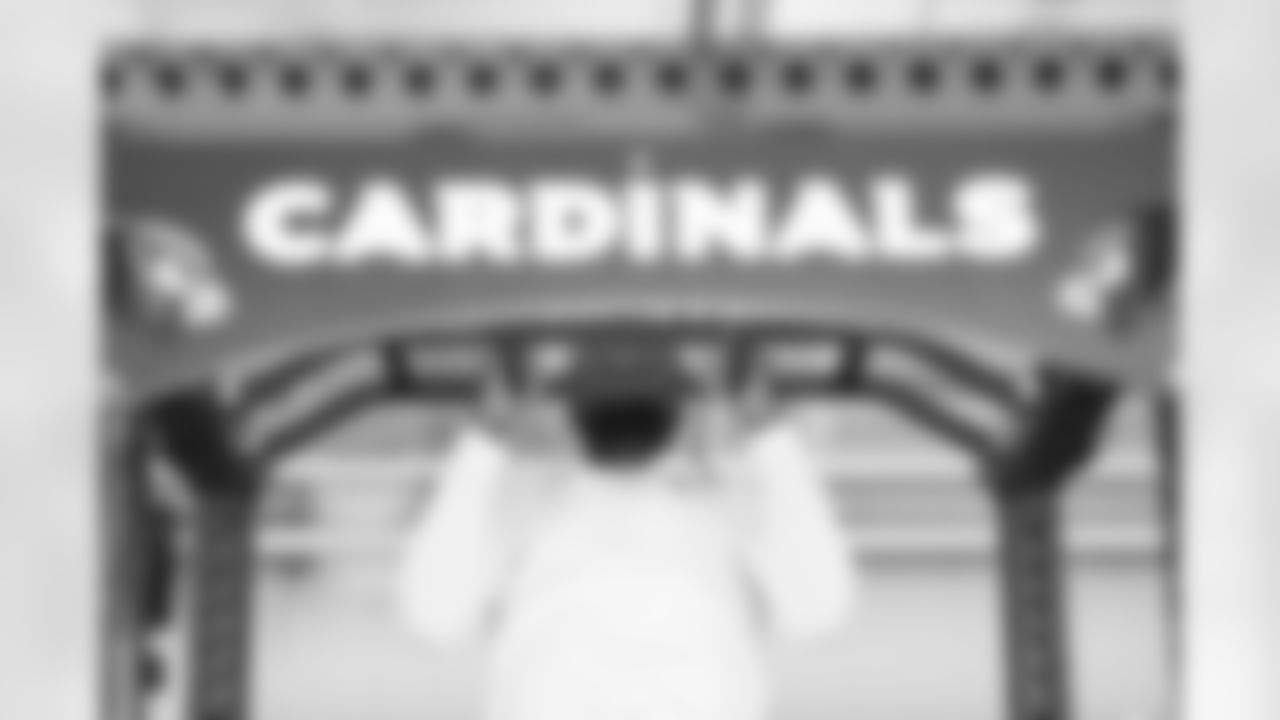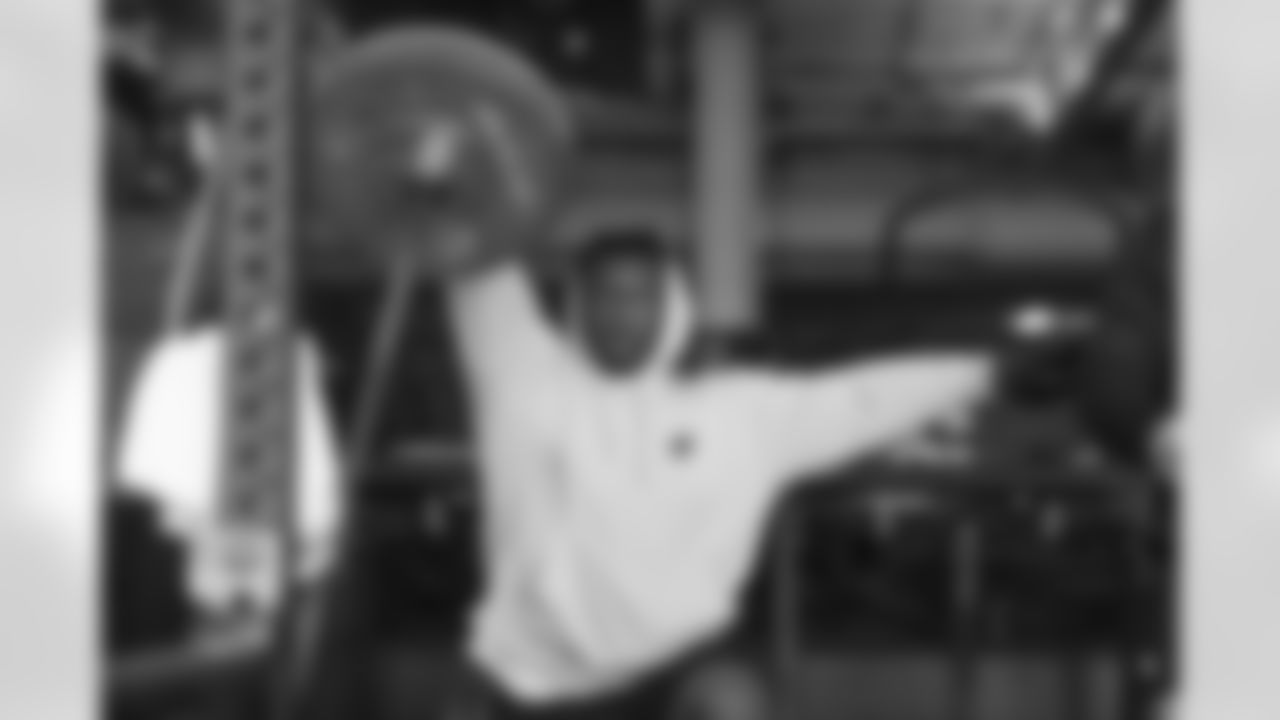The post came from NFL draft analyst Daniel Jeremiah recently, a nod to the draft capital – and endless possibilities – Cardinals GM Monti Ossenfort has in play later this week.
"This draft," Jeremiah wrote on X, "will determine the next 5-7 years for the Arizona Cardinals."
A few days later, ESPN draft analyst Field Yates took the airwaves with a similar thought.
"Regardless of whether they trade up, down or somewhere in between," Yates said, "the Cardinals have a chance to absolutely reshape the franchise."
The Cardinals have their franchise QB in Kyler Murray. To have that plus six picks in the top 90 in the draft – including 4 and 27 in the first round – can drastically alter the future. With Ossenfort still in the midst of changing over the roster from the previous regime anyway, some of this was organic.
Yet the right choices with so many early picks makes it easy to envision what the pundits are thinking.
"We've got to get the right guys," Ossenfort said. "Again, the best way, at least in my belief, to build a roster, to build a core and to build a foundation is through the draft. We think we took the right steps last year in doing that with the group that we added last year, and that's the goal for this year: To add another group like we did last year (and) carve out a role, be the right type of people and be the right type of leaders."
Ossenfort famously maneuvered all around last year in his first draft, going from 3 to 12 and back up to 6 before taking tackle Paris Johnson Jr. Similar options figure to be there this year with teams clamoring for quarterbacks in the top four.
Then again, with the Cardinals in need of a receiver and there being three considered above the others -- Marvin Harrison Jr., as well as Rome Odunze and Malik Nabers – staying in place to make a choice might make more sense.
"I can't wait to see what (Ossenfort) does," Jeremiah said.
Jeremiah acknowledged the Cardinals still need blue-chip players – "You can't always trade back and keep getting more and more and more picks. Eventually you've got to add" – but also said that can be done as well as moving around the board some and perhaps add some future picks. (The Cardinals have six picks in 2025 currently; their seventh-rounder was dealt away in the trade for wide receiver Robbie Chosen in 2022.)
"I love, when you've got all this capital, 'Let's not spend it all this year,'" Jeremiah said.
The Cardinals aren't going into the draft expecting to add picks for 2025, Ossenfort said – although if the Cardinals move back from 4, that would be a near-certainty.
"It just so happens that this year we have more swings at the plate with the volume of picks that we have," Ossenfort said. "Whether we have five picks or 10 picks or 11 picks, whatever it is, we take every pick seriously and we put a lot into selecting those.
"This draft is important. Last year's draft was important. Next year's draft is important. Every draft is going to be of the utmost importance as long as we're here."
The Cardinals will play rookies. Coach Jonathan Gannon proved that last year with tackle Paris Johnson Jr. playing every snap, Michael Wilson starting at wide receiver, and cornerback Garrett Williams and defensive linemen Dante Stills earning significant playing time.
But Ossenfort said it was "unfair" to predict how many starters might come out of this (or any) particular draft, given that no player will just be handed a job based on draft status.
Then again, if the Cardinals pick at 4 and don't trade, it's probably to grab a player who indeed will slide right into the lineup. And they will have more chances at such a thing at 27, and 35, and so on.
"This is a set-your-franchise-up situation here for the Arizona Cardinals," Jeremiah said, noting the number of Super Bowl teams over the years that could point to one- or two-year periods where the draft made such a difference.
"This is their moment here."
Images of the Arizona Cardinals working out at the Dignity Health Training Facility during the first week of the NFL offseason program

Arizona Cardinals defensive Naquan Jones (96) during 2024 offseason workouts Wednesday, Apr 17, 2024 in Tempe, AZ.

Arizona Cardinals wide receiver Jeff Smith (86) during 2024 offseason workouts Monday, Apr 15, 2024 in Tempe, AZ.

Arizona Cardinals offensive lineman Dennis Daley (71) during 2024 offseason workouts Monday, Apr 15, 2024 in Tempe, AZ.

Arizona Cardinals running back Tony Jones (37) during 2024 offseason workouts Monday, Apr 15, 2024 in Tempe, AZ.

The Arizona Cardinals during 2024 offseason workouts Monday, Apr 15, 2024 in Tempe, AZ.

Arizona Cardinals tight end Trey McBride (85) during 2024 offseason workouts Tuesday, Apr 16, 2024 in Tempe, AZ.

Arizona Cardinals wide receiver Michael Wilson (14) during 2024 offseason workouts Monday, Apr 15, 2024 in Tempe, AZ.

Arizona Cardinals offensive lineman Jon Gaines II (59) during 2024 offseason workouts Monday, Apr 15, 2024 in Tempe, AZ.

Arizona Cardinals safety Budda Baker (3) during 2024 offseason workouts Monday, Apr 15, 2024 in Tempe, AZ.

Arizona Cardinals wide receiver Jeff Smith (86) during 2024 offseason workouts Tuesday, Apr 16, 2024 in Tempe, AZ.

Arizona Cardinals wide receiver Michael Wilson (14) during 2024 offseason workouts Monday, Apr 15, 2024 in Tempe, AZ.

Arizona Cardinals tight end Trey McBride (85) during 2024 offseason workouts Monday, Apr 15, 2024 in Tempe, AZ.

Arizona Cardinals linebacker Tyreke Smith (50) during 2024 offseason workouts Monday, Apr 15, 2024 in Tempe, AZ.

Arizona Cardinals punter Blake Gillikin (12) during 2024 offseason workouts Monday, Apr 15, 2024 in Tempe, AZ.

Arizona Cardinals linebacker Jesse Luketa (43) during 2024 offseason workouts Monday, Apr 15, 2024 in Tempe, AZ.

Arizona Cardinals tight end Elijah Higgins (84) during 2024 offseason workouts Tuesday, Apr 16, 2024 in Tempe, AZ.

Arizona Cardinals cornerback Quavian White (38) during 2024 offseason workouts Monday, Apr 15, 2024 in Tempe, AZ.

Arizona Cardinals quarterback Kyler Murray (1) during 2024 offseason workouts Tuesday, Apr 16, 2024 in Tempe, AZ.

Arizona Cardinals wide receiver Jeff Smith (86) during 2024 offseason workouts Monday, Apr 15, 2024 in Tempe, AZ.

Arizona Cardinals quarterback Kyler Murray (1) during 2024 offseason workouts Monday, Apr 15, 2024 in Tempe, AZ.

Arizona Cardinals offensive lineman Will Hernandez (76) during 2024 offseason workouts Monday, Apr 15, 2024 in Tempe, AZ.

Arizona Cardinals quarterback Kyler Murray (1) during 2024 offseason workouts Monday, Apr 15, 2024 in Tempe, AZ.

Arizona Cardinals cornerback Divaad Wilson (27) during 2024 offseason workouts Monday, Apr 15, 2024 in Tempe, AZ.

Arizona Cardinals wide receiver Michael Wilson (14) during 2024 offseason workouts Tuesday, Apr 16, 2024 in Tempe, AZ.

Arizona Cardinals wide receiver Greg Dortch (4) during 2024 offseason workouts Monday, Apr 15, 2024 in Tempe, AZ.

Arizona Cardinals wide receiver Zach Pascal (0) during 2024 offseason workouts Tuesday, Apr 16, 2024 in Tempe, AZ.

Arizona Cardinals defensive tackle Dante Stills (55) during 2024 offseason workouts Monday, Apr 15, 2024 in Tempe, AZ.

Arizona Cardinals quarterback Clayton Tune (15) during 2024 offseason workouts Tuesday, Apr 16, 2024 in Tempe, AZ.

Arizona Cardinals defensive lineman L.J. Collier (91) during 2024 offseason workouts Monday, Apr 15, 2024 in Tempe, AZ.

Arizona Cardinals running back Michael Carter (22) during 2024 offseason workouts Tuesday, Apr 16, 2024 in Tempe, AZ.

Arizona Cardinals wide receiver Andre Baccellia (82) during 2024 offseason workouts Monday, Apr 15, 2024 in Tempe, AZ.

Arizona Cardinals safety Budda Baker (3) during 2024 offseason workouts Monday, Apr 15, 2024 in Tempe, AZ.

Arizona Cardinals quarterback Kyler Murray (1) during 2024 offseason workouts Monday, Apr 15, 2024 in Tempe, AZ.

Arizona Cardinals linebacker BJ Ojulari (18) during 2024 offseason workouts Monday, Apr 15, 2024 in Tempe, AZ.

Arizona Cardinals linebacker Owen Pappoe (44) during 2024 offseason workouts Monday, Apr 15, 2024 in Tempe, AZ.

Arizona Cardinals cornerback Kei'Trel Clark (13) during 2024 offseason workouts Monday, Apr 15, 2024 in Tempe, AZ.

Arizona Cardinals cornerback Michael Ojemudia (29) during 2024 offseason workouts Monday, Apr 15, 2024 in Tempe, AZ.

Arizona Cardinals linebacker Kyzir White (7) during 2024 offseason workouts Monday, Apr 15, 2024 in Tempe, AZ.

Arizona Cardinals offensive lineman Austen Pleasants (67) during 2024 offseason workouts Tuesday, Apr 16, 2024 in Tempe, AZ.

Arizona Cardinals tight end Blake Whiteheart (89) during 2024 offseason workouts Tuesday, Apr 16, 2024 in Tempe, AZ.

Arizona Cardinals defensive lineman L.J. Collier (91) during 2024 offseason workouts Tuesday, Apr 16, 2024 in Tempe, AZ.

Arizona Cardinals offensive lineman Elijah Wilkinson (65) during 2024 offseason workouts Tuesday, Apr 16, 2024 in Tempe, AZ.

Arizona Cardinals offensive lineman Hjalte Froholdt (72) during 2024 offseason workouts Tuesday, Apr 16, 2024 in Tempe, AZ.

Arizona Cardinals defensive tackle Dante Stills (55) during 2024 offseason workouts Tuesday, Apr 16, 2024 in Tempe, AZ.

Arizona Cardinals tight end Trey McBride (85) during 2024 offseason workouts Tuesday, Apr 16, 2024 in Tempe, AZ.

Arizona Cardinals running back DeeJay Dallas (20) during 2024 offseason workouts Tuesday, Apr 16, 2024 in Tempe, AZ.

Arizona Cardinals quarterback Clayton Tune (15) during 2024 offseason workouts Tuesday, Apr 16, 2024 in Tempe, AZ.

Arizona Cardinals tight end Bernhard Seikovits (80) during 2024 offseason workouts Monday, Apr 15, 2024 in Tempe, AZ.

Arizona Cardinals linebacker Mack Wilson (2) during 2024 offseason workouts Tuesday, Apr 16, 2024 in Tempe, AZ.

Arizona Cardinals linebacker Zaven Collins (25) during 2024 offseason workouts Monday, Apr 15, 2024 in Tempe, AZ.

Arizona Cardinals safety Budda Baker (3) during 2024 offseason workouts Tuesday, Apr 16, 2024 in Tempe, AZ.

Arizona Cardinals wide receiver Greg Dortch (4) during 2024 offseason workouts Monday, Apr 15, 2024 in Tempe, AZ.

Arizona Cardinals linebacker Kyzir White (7) and Arizona Cardinals safety Budda Baker (3) during 2024 offseason workouts Tuesday, Apr 16, 2024 in Tempe, AZ.

Arizona Cardinals quarterback Desmond Ridder (9) during 2024 offseason workouts Tuesday, Apr 16, 2024 in Tempe, AZ.

Arizona Cardinals defensive Naquan Jones (96) during 2024 offseason workouts Monday, Apr 15, 2024 in Tempe, AZ.

Arizona Cardinals offensive lineman Paris Johnson Jr. (70) during 2024 offseason workouts Tuesday, Apr 16, 2024 in Tempe, AZ.

Arizona Cardinals tight end Elijah Higgins (84) during 2024 offseason workouts Wednesday, Apr 17, 2024 in Tempe, AZ.

Arizona Cardinals wide receiver Daniel Arias (38) during 2024 offseason workouts Wednesday, Apr 17, 2024 in Tempe, AZ.

Arizona Cardinals tight end Blake Whiteheart (89) during 2024 offseason workouts Wednesday, Apr 17, 2024 in Tempe, AZ.

Arizona Cardinals running back Michael Carter (22) during 2024 offseason workouts Wednesday, Apr 17, 2024 in Tempe, AZ.

Arizona Cardinals defensive lineman Phil Hoskins (79) during 2024 offseason workouts Wednesday, Apr 17, 2024 in Tempe, AZ.

Arizona Cardinals defensive lineman Phil Hoskins (79) during 2024 offseason workouts Wednesday, Apr 17, 2024 in Tempe, AZ.

Arizona Cardinals defensive Naquan Jones (96) during 2024 offseason workouts Wednesday, Apr 17, 2024 in Tempe, AZ.

Arizona Cardinals cornerback Divaad Wilson (27) during 2024 offseason workouts Wednesday, Apr 17, 2024 in Tempe, AZ.

Arizona Cardinals defensive tackle Dante Stills (55) during 2024 offseason workouts Wednesday, Apr 17, 2024 in Tempe, AZ.

Arizona Cardinals offensive lineman Dennis Daley (71) during 2024 offseason workouts Wednesday, Apr 17, 2024 in Tempe, AZ.

Arizona Cardinals linebacker BJ Ojulari (18) during 2024 offseason workouts Wednesday, Apr 17, 2024 in Tempe, AZ.

Arizona Cardinals defensive lineman Khyiris Tonga (95) during 2024 offseason workouts Wednesday, Apr 17, 2024 in Tempe, AZ.

Arizona Cardinals defensive lineman Phil Hoskins (79) during 2024 offseason workouts Wednesday, Apr 17, 2024 in Tempe, AZ.

A general view during 2024 offseason workouts Wednesday, Apr 17, 2024 in Tempe, AZ.

Arizona Cardinals cornerback Kei'Trel Clark (13) during 2024 offseason workouts Wednesday, Apr 17, 2024 in Tempe, AZ.

Arizona Cardinals wide receiver Greg Dortch (4) during 2024 offseason workouts Wednesday, Apr 17, 2024 in Tempe, AZ.

Arizona Cardinals cornerback Bobby Price (26) during 2024 offseason workouts Wednesday, Apr 17, 2024 in Tempe, AZ.

Arizona Cardinals safety Joey Blount (32) and Arizona Cardinals cornerback Divaad Wilson (27) during 2024 offseason workouts Wednesday, Apr 17, 2024 in Tempe, AZ.

A general view during 2024 offseason workouts Wednesday, Apr 17, 2024 in Tempe, AZ.

Arizona Cardinals offensive lineman Evan Brown (62) during 2024 offseason workouts Wednesday, Apr 17, 2024 in Tempe, AZ.

Arizona Cardinals offensive lineman Will Hernandez (76), Arizona Cardinals offensive lineman Hjalte Froholdt (72) and Arizona Cardinals offensive lineman Elijah Wilkinson (65) during 2024 offseason workouts Wednesday, Apr 17, 2024 in Tempe, AZ.

Arizona Cardinals quarterback Kyler Murray (1) during 2024 offseason workouts Wednesday, Apr 17, 2024 in Tempe, AZ.

Arizona Cardinals tight end Trey McBride (85) during 2024 offseason workouts Wednesday, Apr 17, 2024 in Tempe, AZ.

Arizona Cardinals cornerback Sean Murphy-Bunting (23) during 2024 offseason workouts Wednesday, Apr 17, 2024 in Tempe, AZ.

Arizona Cardinals wide receiver Michael Wilson (14) and Arizona Cardinals wide receiver Daniel Arias (38) during 2024 offseason workouts Wednesday, Apr 17, 2024 in Tempe, AZ.

Arizona Cardinals wide receiver Greg Dortch (4) and Arizona Cardinals wide receiver Zach Pascal (0) during 2024 offseason workouts Wednesday, Apr 17, 2024 in Tempe, AZ.

Arizona Cardinals tight end Blake Whiteheart (89), Arizona Cardinals tight end Elijah Higgins (84), Arizona Cardinals tight end Bernhard Seikovits (80), Arizona Cardinals tight end Travis Vokolek (81) and Arizona Cardinals tight end Trey McBride (85) during 2024 offseason workouts Wednesday, Apr 17, 2024 in Tempe, AZ.

Arizona Cardinals wide receiver Michael Wilson (14) during 2024 offseason workouts Thursday, April 18, 2024 in Tempe, AZ.

Arizona Cardinals running back Michael Carter (22) during 2024 offseason workouts Thursday, April 18, 2024 in Tempe, AZ.

Arizona Cardinals offensive lineman Marquis Hayes (78) during 2024 offseason workouts Thursday, April 18, 2024 in Tempe, AZ.

Arizona Cardinals linebacker Jesse Luketa (43) during 2024 offseason workouts Thursday, April 18, 2024 in Tempe, AZ.

Arizona Cardinals linebacker Owen Pappoe (44) during 2024 offseason workouts Thursday, April 18, 2024 in Tempe, AZ.

Arizona Cardinals offensive lineman Paris Johnson Jr. (70) during 2024 offseason workouts Thursday, April 18, 2024 in Tempe, AZ.

The Arizona Cardinals during 2024 offseason workouts Thursday, April 18, 2024 in Tempe, AZ.

Arizona Cardinals linebacker Dennis Gardeck (45) during 2024 offseason workouts Thursday, April 18, 2024 in Tempe, AZ.

Arizona Cardinals linebacker Jesse Luketa (43) and Arizona Cardinals linebacker Tyreke Smith (50) during 2024 offseason workouts Thursday, April 18, 2024 in Tempe, AZ.

Arizona Cardinals safety Budda Baker (3) during 2024 offseason workouts Thursday, April 18, 2024 in Tempe, AZ.

Arizona Cardinals wide receiver Dan Chisena (16) during 2024 offseason workouts Thursday, April 18, 2024 in Tempe, AZ.

Arizona Cardinals wide receiver Greg Dortch (4) during 2024 offseason workouts Thursday, April 18, 2024 in Tempe, AZ.

Arizona Cardinals tight end Bernhard Seikovits (80) during 2024 offseason workouts Thursday, April 18, 2024 in Tempe, AZ.

Arizona Cardinals tight end Trey McBride (85) during 2024 offseason workouts Thursday, April 18, 2024 in Tempe, AZ.

Arizona Cardinals linebacker Krys Barnes (51) during 2024 offseason workouts Thursday, April 18, 2024 in Tempe, AZ.

Arizona Cardinals wide receiver Michael Wilson (14) during 2024 offseason workouts Thursday, April 18, 2024 in Tempe, AZ.

Arizona Cardinals tight end Trey McBride (85) during 2024 offseason workouts Thursday, April 18, 2024 in Tempe, AZ.

Arizona Cardinals offensive lineman Evan Brown (62) during 2024 offseason workouts Thursday, April 18, 2024 in Tempe, AZ.

The Arizona Cardinals during 2024 offseason workouts Thursday, April 18, 2024 in Tempe, AZ.

Arizona Cardinals offensive lineman Will Hernandez (76) during 2024 offseason workouts Thursday, April 18, 2024 in Tempe, AZ.

Arizona Cardinals running back Emari Demercado (31) during 2024 offseason workouts Thursday, April 18, 2024 in Tempe, AZ.

Arizona Cardinals quarterback Kyler Murray (1) during 2024 offseason workouts Thursday, April 18, 2024 in Tempe, AZ.

Arizona Cardinals quarterback Kyler Murray (1) during 2024 offseason workouts Thursday, April 18, 2024 in Tempe, AZ.

Arizona Cardinals wide receiver Daniel Arias (38) during 2024 offseason workouts Thursday, April 18, 2024 in Tempe, AZ.

Arizona Cardinals wide receiver Greg Dortch (4) during 2024 offseason workouts Thursday, April 18, 2024 in Tempe, AZ.

Arizona Cardinals quarterback Clayton Tune (15) during 2024 offseason workouts Thursday, April 18, 2024 in Tempe, AZ.

Arizona Cardinals wide receiver Jeff Smith (86) during 2024 offseason workouts Thursday, April 18, 2024 in Tempe, AZ.

Arizona Cardinals wide receiver Chris Moore (10) during 2024 offseason workouts Thursday, April 18, 2024 in Tempe, AZ.

Arizona Cardinals offensive lineman Jonah Williams (73) during 2024 offseason workouts Thursday, April 18, 2024 in Tempe, AZ.

Arizona Cardinals wide receiver Jeff Smith (86) during 2024 offseason workouts Thursday, April 18, 2024 in Tempe, AZ.















